| |
 |
 |
 |
 |
BILL
EPPS
|
 |
I do a lot of shows where I am demonstrating for the public, and it seems like there's always somebody comin' by looking for a "Cheap" Anvil. So, here's how we smiths can make and sell a $20. anvil.
|
 |
 |

Figure 02 |
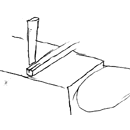
Figure 03 |

Figure 04 |
 |
BILL
EPPS
|
 |
This one I made out of 1/2" square, I've made them out of 3/8" sq. 1/2", 3/4" and 1". Depends on what size you are after. This one was for a key chain/ I start by using a hot cutter, splitting the end 1/2" back, do it 1/2 from one side then the other side.
|
 |
 |
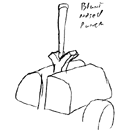
Figure 05 |
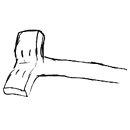
Figure 06 |
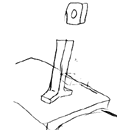
Figure 07 |
 |
BILL
EPPS
|
 |
After we make the split, I go to the vice and use a blunt nosed punch to radius the bottom of the cut so you don't have a cold shunt. Then set it up on the anvil from the long end. I do this to get what will become the face of the anvil good and flat.
|
 |
 |
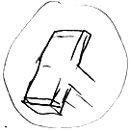
Figure 08 |
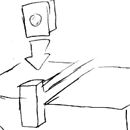
Figure 09 |

Figure 10 |
 |
BILL
EPPS
|
 |
After we flatten it it out, then I come to the face of the anvil and I start squaring it up. Usually I get my split a little bit off center, so I end up w/ one side a little thinner than the other, so that the side that I use for the horn.
|
 |
 |

Figure 10 |
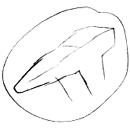
Figure 11 |

Figure 12 |
 |
BILL
EPPS
|
 |
Then I start to taper the horn w/hammer on the face of the anvil, then I dress it up a little bit w/a hot rasp. (Old Farrier's rasp works real good for this).
|
 |
 |

Figure 13 |

Figure 14 |
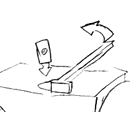
Figure 15 |
 |
BILL
EPPS
|
 |
After I get the horn (rough) shaped, I set it down off the side of the anvil to start the step. If you set it down w/a half blow, then hammer on the tail a little bit, it will crisp up the step. Then come back, to the face of the anvil and reround the horn back up.
|
 |
 |
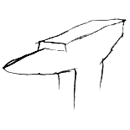
Figure 16 |

Figure 17 |
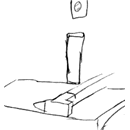
Figure 18 |
 |
BILL
EPPS
|
 |
After getting the step shaped, I go back to the vice and finish dressing the horn w/a hot rasp. Then we use a hot cutter about 3/4" back from the bottom of the face to cut the piece loose. Do this again 1/2 from one side and 1/2 from the other side. The reasons for this is to keep from forcing all the metal to one side as well as saving the face of the anvil. When thin enough, just break it off in the vice w/pair of tongs.
|
 |
 |

Figure 19 |
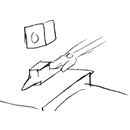
Figure 20 |

Figure 21 |
 |
BILL
EPPS
|
 |
The reason I cut it off long, is so I can turn it face down on the anvil and upset the base a little bit. (I don't mention everytime I take a heat, cause I figure you will know when you need to reheat the metal when you are working it).
|
 |
 |

Figure 22 |
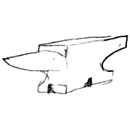
Figure 23 |
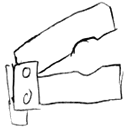
Figure 24 |
 |
BILL
EPPS
|
 |
Now use the hot cutter again (an old cold chisel works well for this also), I make a cut about 1/8 to 3/16" of an inch deep across the bottom and then across the length of the bottom. This allows the impression of 4 feet to come out.
|
 |
 |

Figure 24 |
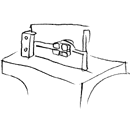
Figure 25 |
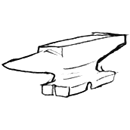
Figure 26 |
 |
BILL
EPPS
|
 |
I use a guillotine tool on the sides, under the horn and under the tail to establish the waist of the anvil. You only go deep enough to put a radius on it and to make the waist of the anvil.
|
 |
 |
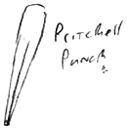
Figure 27 |
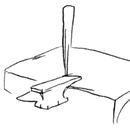
Figure 28 |

Figure 29 |
 |
BILL
EPPS
|
 |
Then using a squared up pritchel punch, I punch the hardy hole. (a little over 1/8" square).
|
 |
 |

Figure 00 |
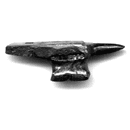
Figure 01 |
 |
 |
BILL
EPPS
|
 |
It should end up looking something similar to this (w/out all the shadows). These are a fun thing to make and takes about 20 to 30 minutes. Then you can put a key chain ring in it or whatever.
Any questions??? :)
|
 |
STEVE-C
|
 |
Cute little thing :)
|
 |
PAW-PAW
|
 |
Bill, take the hardy hole all the way through to use it for the key ring?
|
 |
NTECH
|
 |
Very Nice demo Bill, Thanks
|
 |
DAVE ATWOOD
|
 |
This is the EPPS model, and stamped?
|
 |
BILL
EPPS
|
 |
Paw-Paw, yes. Thanks Ntech.
Dave I forget to say, the last step is to add your touch mark :)
|
 |
RLD
|
 |
Bill do you freeze the face before upsetting the base?
|
 |
BILL
EPPS
|
 |
RLD, NO. The face is pretty well finished, and I just let it go where it will. As short as it is, I think you would loose too much heat out of the face by trying to freeze the face.
|
 |
BILL
EPPS
|
 |
At one of the conferences I attended, a little bit larger $20 anvil brought $140. Course, auctions for good causes tend to do that:)
|
 |

